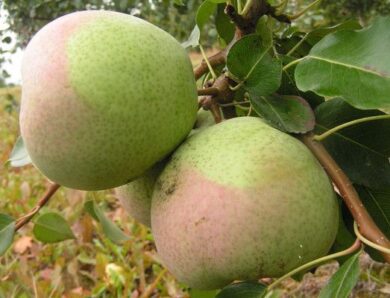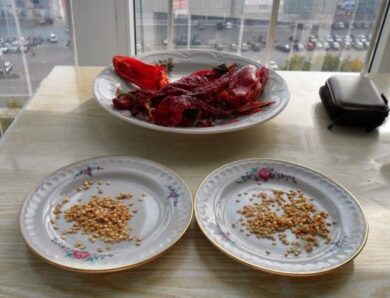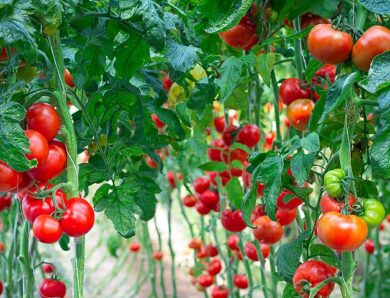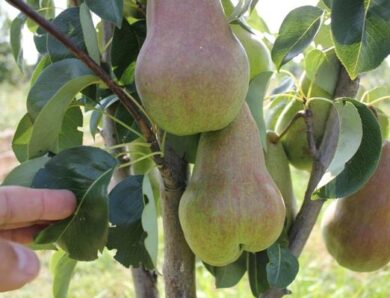Columnar cherry: varieties, description, planting and care
The popularity of columnar fruit trees is growing every year. Today, in almost every garden you can find short pears, apple tree, cherries or plums. Not so long ago, this line was supplemented by a columnar cherry. Growing columnar cherries on the site has many benefits. They are demanding to care, do not take up much space, very decorative during flowering, fruiting and November, therefore always harmoniously complement the landscape space.
Varieties of cherry columnar
Columnar trees in the cherry kingdom are still very few. Three varieties are considered the most popular: Queen, Baby and Delight. However, the last two are most in demand in private horticulture, description of varieties which will be given later in the article.
Baby
Cherry columnar Baby will not only delight you with sweet and big berries, but also decorate your garden in the spring with lush pink inflorescences. The variety is characterized by high yields and the ability to self-pollinate. The trees are low (to 2 m), crown pyramidal, diameter does not exceed 0,8 m. The berries are large (8-10 m), bright red, sweet and sour taste, very fragrant, suitable for any processing.
Cherries of this variety are unpretentious, can grow in any conditions: in the garden, containers, suitable for balconies and terraces. Resistance to disease is average. In humid conditions can be affected by fruit rot, coccidiosis and other fungal diseases. Winter hardiness is also low, for the winter needs shelter and insulation of the trunk.
Delight
Columnar cherry with a promising name Capture is a novelty of the Dutch selection. The variety was bred in 2015 year, but has become widespread in private and industrial gardens. This was facilitated by high varietal characteristics, impressive yield (20-35 kg of adult wood) and the size of the berries (10-15 m). Red-ruby cherry flesh, with small pink streaks, very juicy and sweet. Separation from the stalk is dry, the bones are easily separated from the flesh. The cherry ripens in mid-July.
Trees belong to the dwarf type. When kept in the garden, they reach a height of 1.5–2 m, but the Dutch recommend growing them in pots and containers as ornamentals. The crown is narrowly pyramidal, has virtually no branches. Early fruiting on 2-3 year after planting. The variety is resistant to many diseases, but sensitive to cold. Self-pollination of cherries is partial. To increase yields, it is recommended to plant near the pollinator - cherry Ashinsky hybrid.
Planting and care
Unlike standard trees, columnar cherries have a completely different crown structure, therefore, planting and caring for them have their own characteristics. Example, such cherries do not need much space, they are well lit on all sides, and they can be planted according to the compacted scheme, at a distance of 0.7-0.8 m. With a lack of space, the distance between the trees can even be reduced to 0,5 m, which will not affect their yields.
Almost all varieties of columnar cherries are designed for growing in mild climates, they are more demanding on the composition of the soil, and this should be taken into account.
The main vegetative organ, responsible for the growth of columnar trees, there is an apical bud. If it is damaged or underdeveloped, successful rooting can not be expected, therefore, before planting it is necessary to check the seedlings for the integrity of this bud. In the future it should be protected from frost, as in case of freezing of a top the tree will stop the growth and fruiting.
Caring for cherries consists of watering, top dressing, preventive measures to prevent diseases and pests. A nice bonus is that, that these trees do not need pruning, because their crown grows vertically and has no lateral branches. It is also necessary to monitor the cleanliness of the stem circles, timely loosen them and remove weeds.
In the first year, while the trees take root, it is necessary to keep the soil moist. Adult plants are watered as needed, increasing water consumption on hot days, as well as during the period of tying and ripening of fruits. Scheduled fertilizations are carried out twice a season: in the spring - nitrogen complex (urea, ammonium nitrate), in autumn - phosphorus (150 g under each tree) and potassium (50-60 G). At the stage of cherry blossoms can be fed a weak solution of mullein with ash.
Given the high susceptibility of plants to diseases of fungal origin, twice a year it is recommended to carry out preventive treatment of the crown with fungicides (Bordeaux liquid, Fitosporin). In the summer months, trees can be attacked by aphids. Spraying tobacco infusion with household soap helps to get rid of pests. To avoid infecting the tree with fruit rot, spoiled fruits and damaged leaves should be removed regularly.
Advantages and disadvantages
Cherries with a columnar crown, undoubtedly, have a number of advantages over conventional trees:
- they are compact, which saves planting space;
- short cherries facilitate care and harvesting;
- early fruiting on 2-3 year);
- unpretentious care (you can do without pruning);
- high decorative plants;
- almost all varieties are self-fertile;
- good yield and excellent fruit taste.
The only drawback is, that plants do not tolerate frosty winters, therefore, it is not recommended to grow them in the northern regions.
Video "Planting cherries"
About the useful properties of cherries, selection of seedlings and features of planting this plant and will be discussed in the next video.




